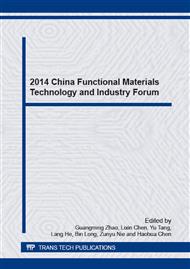p.807
p.815
p.822
p.831
p.837
p.842
p.846
p.855
p.860
High-Rate Capability and Excellent Cycling Stability of Li3V2(PO4)3/C Cathode Material Prepared via Sol-Gel Combined with Ball Milling Method
Abstract:
Li3V2(PO4)3/C is prepared by sol-gel combined with ball milling method (SG-BM). The composites were characterized by X-ray diffraction (XRD), scanning electron microscopy (SEM), transmission electron microscopy (TEM), C-S analysis and galvanostatic charge/discharge measurements. The structural characterization shows that the composite prepared by SG-BM is composed of the well crystallized Li3V2(PO4)3 with the space group P21/n and 6.2 wt.% amorphous carbon. SEM and TEM results show that the prepared composite has uniform size distribution with the narrow range of 0.5-1.5μm, and its surface is covered by a smooth and uniform carbon layer with thickness of about 10nm. Galvanostatic charge/discharge measurements indicate that the composite exhibits high rate capability and excellent cycling stability. The prepared composite delivers a discharge capacity of 131.1mAh/g, 128.9mAh/g, 122.6mAh/g and 113.8mAh/g at 0.5C, 1C, and 10C, respectively. The capacity retention of 100% is achieved after 50 cycles at 1C. This outstanding electrochemical capability is attributed to the ultrafine particles with narrow size distribution and the well-covered carbon layer with proper thickness.
Info:
Periodical:
Pages:
837-841
Citation:
Online since:
December 2014
Authors:
Keywords:
Price:
Сopyright:
© 2015 Trans Tech Publications Ltd. All Rights Reserved
Share:
Citation:


